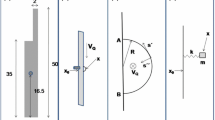Abstract
This paper presents a new technique to produce controlled stretched vortices. Intense elliptical vortices are created by stretching of an initial vorticity sheet. The initial vorticity comes from a laminar boundary layer flow and the stretching is parallel to the vorticity vectors. This low velocity flow enables direct observation of the formation and destabilization of vortices. Visualizations are combined with quasi-instantaneous measurements of a full velocity profile. The velocity profile is obtained with an ultrasonic pulsed Doppler velocimeter. The evolution of the central diameter of the vortices is related to the stretching. It is observed that destabilization occurs by pairing of two vortices, by hairpin deformation, and by breakdown of vortices into a “coil shape”.
Similar content being viewed by others
References
Siggia, E.D., Numerical study of small-scale intermittency in three-dimensional turbulence.J. Fluids Mech. 107 (1981) 375–406.
Brachet, M.E., Meneguzzi, M., Vincent, A., Politano, H. and Sulem, P.L., Numerical evidence of smooth self-similar dynamics and possibility of subsequent collapse for three-dimensional ideal flows.Phys. Fluids A 4(12) (1992) 2845–2954.
Passot, T., Politano, H., Sulem, P.L., Angilella, J.R. and Meneguzzi, M., Instability of strained vortex layers and vortex tube formation in homogeneous turbulence.J. Fluid Mech. 282 (1995) 313–338.
Jiménez, J., Wray, A.A., Saffman, P.G. and Rogallo, R.S., The structure of intense vorticity in homogeneous isotropic turbulence.J. Fluid Mech. 255 (1993) 65–90.
Cadot, O., Douady, S. and Couder, Y., Characterization of the low pressure filaments in three-dimensional turbulent shear flow.Phys. Fluids. 7(3) (1995) 630–646.
Neu, J.C., The dynamics of stretched vortices.J. Fluid Mech. 143 (1984) 253–276.
Moffatt, H.K., Kida, S. and Ohkitani K., Stretched vortices—The sinews of turbulence; Large-Reynolds-number asymptotics.J. Fluid Mech. 259 (1994) 241–264.
Bayly, B., Three-dimensional instability of elliptical flow.Phys. Rev. Lett. 57 (1986) 2160–2163.
Le Dizès, S., Rossi, M. and Moffatt, H. K., On three-dimensional instability of elliptical vortex subjected to stretching.Phys. Fluids 8(8) (1996) 2084–2090.
Burgers, J.M., A mathematical model illustrating the theory of turbulence.Adv. Appl. Mech. 1 (1948) 171–199.
Saffman, P.G. and Baker, G.R., Vortex interactions.Ann. Rev. Fluid Mech. 11 (1979) 95–122.
Hall, M.G., Vortex breakdown.Ann. Rev. Fluid Mech. 4 (1972) 195–218.
Acarlar, M.S. and Smith, C.R., A study of hairpin vortices in laminar boundary layer. Part 2. Hairpin vortices generated by fluid injection.J. Fluid Mech. 175 (1987) 43–84.
Author information
Authors and Affiliations
Rights and permissions
About this article
Cite this article
Petitjeans, P., Wesfreid, JE. Vortex stretching and filaments. Appl. Sci. Res. 57, 279–290 (1996). https://doi.org/10.1007/BF02506064
Received:
Accepted:
Issue Date:
DOI: https://doi.org/10.1007/BF02506064




